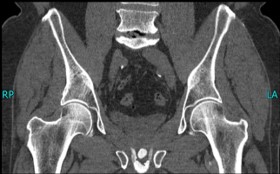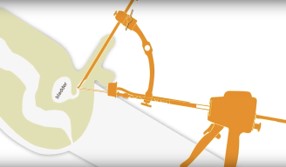Indexing & Abstracting
Full Text
Case ReportDOI Number : 10.36811/jcri.2020.110014Article Views : 10Article Downloads : 6
Injection of a bulking agent to combat urinary incontinence after unsuccessful sling therapy in a patient with post prostatectomy urinary incontinence
Geerkens M, Venema P, Nieuwenhuijzen J and Pigot G*
VU University Medical Center, Amsterdam, Department of Urology, Netherlands
*Corresponding Author: Pigot G, VU University Medical Center, Amsterdam, Department of Urology, 1081 HV Amsterdam, The Netherlands, Email: Garry.Pigot@vumc.nl
Article Information
Aritcle Type: Case Report
Citation: Geerkens M, Venema P, Nieuwenhuijzen J, et al. 2020. Injection of a bulking agent to combat urinary incontinence after unsuccessful sling therapy in a patient with post prostatectomy urinary incontinence. J Case Rept Img. 2: 04-06.
Copyright: This is an open-access article distributed under the terms of the Creative Commons Attribution License, which permits unrestricted use, distribution, and reproduction in any medium, provided the original author and source are credited. Copyright © 2020; Geerkens M
Publication history:
Received date: 17 February, 2020Accepted date: 21 February, 2020
Published date: 24 February, 2020
Introduction
We report a case of a successful treatment of post prostatectomy urinary stress incontinence with bulk injections after failed primary treatment with a sling.
Keywords: Incontinence; Sling; Bulking agent; Therapy; Post-prostatectomy
Case presentation
A 70 year-old man was referred to the Urologen Kliniek Vleuten, with complaints of persistent stress urinary incontinence (SUI). His past medical history includes an open radical prostatectomy for a pT2cNxMx Gleason 6 adenocarcinoma of the prostate, with an initial PSA of 6.6 July 2011. Two years after prostatectomy the patient still complained of mild SUI, despite extensive pelvic floor physiotherapy. To treat the incontinence, an Argus sling was implanted in 2013. Nevertheless, the patient still complained of stress urinary incontinence after this procedure.
After referral of the patient in 2016, the work-up for the SUI consisted of 24 hours voiding chart and 24-hour pad test revealing a bladder capacity of … and the use two pads a day because of the urinary incontinence. An urethroscopy showed a patent urethra and neo-bladder neck, circular contraction of the urinary sphincter and a bladder without abnormalities and with a good capacity. A CT scan of the pelvis showed the sling was positioned properly, with no other abnormalities (figure 1).

Figure 1: Positioning of the sling and prolastic after the second procedure.
During the procedure the patient is positioned in lithotomy position. An urethrocystoscopy is performed with a 19 french rigid cystoscope while the patient is awake. He is instructed to contract the pelvic floor in order to identify the urinary sphincter. The location for the injection of the bulk is thus identified. This is typically just below the urinary sphincter the cystoscope is removed and the patient receives general anaesthesia. Meanwhile the Prolastic applicator sets are attached to the cystoscope and the position of the needles with relation to the tip of the cystoscope is decided upon. The tips of the needles are situated at 5 and 7 o’clock in relation to the top of the cystoscope (figure 2).

Figure 2: Illustrating cystoscope attached to Prolastic® applicator support and prolastic pistole [10].
The cystoscope is again introduced in the urethra and the needles are advanced through the perineum. Despite the deposition of 1,6 cc of bulking agent Prolastic, at 5 and 7 o’clock at 1 cm below the neobladder neck to increase the intra-urethral closing pressure, the patient did not experience any improvement. A second procedure followed three months after the initial procedure. 12 months after therapy the patient still is fully continent, and pads are no longer necessary.
Discussion
Stress urinary incontinence is defined as the complaint of involuntary leakage on effort on exertion, or on sneezing or coughing [1]. Postprostatectomy stress incontinence is a result of different factors, including dysfunction of the internal sphincter, caused by the surgery. Physical examination and a bladder diary are used to objectify the diagnosis, whereas the pad-test can be used to quantify the degree of incontinence [2]. The prevalence of postprostatectomy incontinence is widely reported, varying from 1-40% [3]. As a consequence, 6% of post-prostatectomy patients undergo at least one surgical treatment for stress urinary incontinence [4]. The surgical treatment consists of the three following options; the injection of a bulking agent, implementation of a sling or an artificial urinary sphincter (AUS). [5] The choice depends on the severity of the incontinence.
Sling application is indicated in cases of mildto- moderate post prostatectomy incontinence. There are two theories that try to explain the effect of a sling. First, slings reposition the bulb of the urethra, second slings restore the urethral compression, like the Argus® [5]. The success rate of the Argus sling has been reported to be up to 66% after three years of implantation [6]. According to the EAU guidelines a bulking agency is an optional therapy for men with mild post-prostatectomy incontinence with a desire of temporary relief of the symptoms [7]. Though the results of bulking agents are less than slings or AUS, the injection of bulking agents, is considered the least invasive option of the surgical treatments for male SUI.
During this treatment bulk is injected at the dorso-lateral sides of the urethra (at 5 and 7 o’clock) to increase coaptation at the level of the internal sphincter. Prolastic® is a nonresorbable bulking agent consisting of vinyldimethyl terminated polydimethylsiloxane (PDMS) polymer, which is injected para-urethral during a cystourethroscopy. The advantage above other bulking agents could be successful long-term outcomes because of this non-resorbable material. Success rate of Prolastic® is unknown, success rate of other bulk materials has been reported to be up to 46% [8].
Data of Urolastic bulking agents also made from PDMS by the same manufacturer as Prolastic, used for female patients with stress urinary incontinence showed good functional results with moderate adverse complications [9]. In this case we showed that a bulking agent could be used as a supplementary therapy for stress urinary post prostatectomy incontinence after a sling procedure was inadequate.
Conclusion
The use of a bulking agent can be considered in cases of persistent stress urinary incontinence after a sling procedure for post-prostatectomy incontinence proved insufficient.
References
1. Abrams P, Cardozo L, Fall M, et al. 2003. The standardization of terminology in lower urinary tract function: report from the standardization sub-committee of the International Continence Society. Urology. 61: 37-49. Ref.: https://www.ncbi.nlm.nih.gov/pubmed/12559262
2. Milsom I, Altman D, Lapitan MC, et al. 2009. Epidemiology of urinary (UI) and faecal (FI) incontinence & pelvic organ prolapse (POP) incontinence: 4th international consultation on incontinence. Paris, France Health publication ltd. 35- 112. Ref.: https://bit.ly/2HIbO6m
3. Krupski TL, Saigal CS, Litwin MS. 2003. Variation in continence by definition. J Urol. 170: 1291-1294. Ref.: https://www.ncbi.nlm.nih.gov/pubmed/14501744
4. Kim PH, Pinheiro LC, Atoria CL, et al. 2013. Trends in the use of incontinence procedures after radical prostatectomy: a population based analysis. J Urol. 189: 602-608. Ref.: https://www.ncbi.nlm.nih.gov/pubmed/23017528
5. Herschorn S, Bruschini H, Comiter C, et al. 2010. Surgical Treatment of Stress Incontinence in Men. Neurourol Urodyn. 29: 179-190. Ref.: https://www.ncbi.nlm.nih.gov/pubmed/20025026
6. Romano SV, Metrebian SE, Vaz F, et al. 2009. Long-term results of a phase III multicenter trial of the adjustable male sling for treating urinary incontinence after prostatectomy: minimum 3 years. Actas Urol Esp. 33: 309-314. Ref.: https://www.ncbi.nlm.nih.gov/pubmed/19537070
7. Lucas MG, Bosch RJ, Burkhard FC, et al. 2013. EAU guidelines on surgical treatment of urinary incontinence. Actas Urol Esp. 37: 459-472. Ref.: https://www.ncbi.nlm.nih.gov/pubmed/23835037
8. Silva LA, Andriolo RB, Atallah ÁN, et al. 2014. Surgery for stress urinary incontinence due to presumed sphincter deficiency after prostate surgery. Cochrane Database Syst Rev. 9. Ref.: https://www.ncbi.nlm.nih.gov/pubmed/25261861
9. Capobianco, Azzena A, Saderi L, et al. 2018. Urolastic®, a new bulking agent for treatment of stress urinary incontinence: a systematic review and meta-analysis. Int Urogynecol J. 29: 1239-1247. Ref.: https://www.ncbi.nlm.nih.gov/pubmed/29934769
10. Urogynbv. Prolastic. 31-10-17 Available from: http://www.urogynbv.com/nl/prolastic/




















